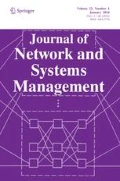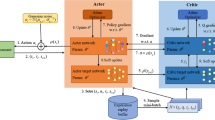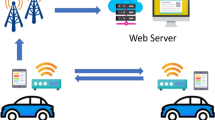Abstract
With the development of network function virtualization (NFV) and mobile edge computing (MEC), service function chaining (SFC) can be deployed more flexibly on the network edge to provide users with higher quality services. However, the mobility of users might affect the quality of the perceived service and even cause service unavailability. It is thus a challenge to better migrate the service function chains to reduce prevent such degradation and improve the migration success rate. This paper investigates the SFC migration timing decision problem in user predicted movement scenarios with a known mobile path and predicted arrival time. First, we establish an prediction model of user arrival time and formulate the SFC migration process as a mathematical model. Then, we model the SFC migration process as a Markov decision process, and propose a deep Q-network based SFC migration timing decision (DQN-MTD) algorithm. DQN-MTD can be useful to perceive and predict the state changes of network resources, and select appropriate migration timing for virtual network functions (VNFs) based on SFC migration information. The experimental results show that compared with existing algorithms, DQN-MTD algorithm can reduce the average service downtime by about 14%, improve the migration success rate of SFC by about 20%, and reduce the average VNF migration time and memory when network load is low.













Similar content being viewed by others
References
ETSI: Network functions virtualisation (NFV); architectural framework, ETSI GS NFV 002 (V1.2.1). European Telecommunications Standards Institute, Sophia-Antipolis (2014)
Halpern, J., Pignataro, C.: Service function chaining (SFC) architecture[M]//RFC 7665 (2015)
Chen, Y.T., Liao, W.J.: Mobility-aware service function chaining in 5G wireless networks with mobile edge computing. In: ICC 2019—2019 IEEE International Conference On Communications (ICC), Shanghai, China, pp. 1–6. (2019)
Zhao, D.C., Sun, G., Liao, D., Xu, S.Z., Chang, V.: Mobile-aware service function chain migration in cloud-fog computing. Future Gener. Comput. Syst. 96, 591–604 (2019). https://doi.org/10.1016/j.future.2019.02.031
Zhang, F., Liu, G.M., Fu, X.M., Yahyapour, R.: A survey on virtual machine migration: Challenges, techniques and open issues. IEEE Commun. Surv. Tutor. (2018). https://doi.org/10.1109/COMST.2018.2794881
Taleb, T., Ksentini, A., Frangoudis, P.A.: Follow-me cloud: When cloud services follow mobile users. IEEE Trans. Cloud Comput. 7, 369–382 (2019). https://doi.org/10.1109/TCC.2016.2525987
Lu, X., Wetter, E., Bharti, N., Tatem, A.J., Bengtsson, L.: Approaching the limit of predictability in human mobility. Sci. Rep. (2013). https://doi.org/10.1038/srep02923
Song, C.M., Qu, Z.H., Blumm, N., Barabasi, A.L.: Limits of predictability in human mobility. Science 327(5968), 1018–1021 (2010). https://doi.org/10.1126/science.1177170
Kulkarni, V., Mahalunkar, A., Garbinato, B., Kelleher, J.D.: Examining the limits of predictability of human mobility. Entropy (2019). https://doi.org/10.3390/e21040432
Gao Z., Tsiopoulos A., Friderikos V.: Dynamic VNF chains placement for mobile iot applications. In: GLOBECOM 2019—2019 IEEE global communications conference. IEEE (2019)
Hu, H.F., Yang, C., Xu, L.Y., Song, T.Y.J., Dalia, B.B.: Path load adaptive migration for routing and bandwidth allocation in mobile-aware service function chain. Electron. Newsweekly (2022). https://doi.org/10.3390/electronics11010057
Huang, Y.P., Chen, C., Su, Z.C., Chen, T.S., Sumalee, A., Pan, T.L., Zhong, R.X.: Bus arrival time prediction and reliability analysis: An experimental comparison of functional data analysis and Bayesian support vector regression. Appl. Soft Comput. (2021). https://doi.org/10.1016/j.asoc.2021.107663
Zou, Y.J., Zhu, X.X., Zhang, Y.L., Zeng, X.S.: A space–time diurnal method for short-term freeway travel time prediction. Transp. Res. C 43, 33–49 (2014). https://doi.org/10.1016/j.trc.2013.10.007
Ayoub, O., Huamani, O., Musumeci, F., Tornatore, M.: Efficient online virtual machines migration for alert-based disaster resilience. In: International conference on the design of reliable communication networks (DRCN 2019). (2019)
Carpio F., Jukan A., Pries R.: Balancing the migration of virtual network functions with replications in data centers. In: IEEE/IFIP network operations and management symposium (NOMS). (2017)
Eramo, V., Ammar, M., Lavacca, F.G.: Migration energy aware reconfigurations of virtual network function instances in NFV architectures. IEEE Access 5, 4927–4938 (2017). https://doi.org/10.1109/ACCESS.2017.2685437
Yang, L., Yang, D.D., Cao, J.N., Sahni, Y., Xu, X.H.: QoS guaranteed resource allocation for live virtual machine migration in edge clouds. IEEE Access (2020). https://doi.org/10.1109/ACCESS.2020.2989154
Qu, H., Wang, K., Zhao, J.H.: Priority-awareness VNF migration method based on deep reinforcement learning. Comput. Netw. (2022). https://doi.org/10.1016/j.comnet.2022.108866
Addad, R.A., Dutra, D.L.C., Taleb, T., Flinck, H.: AI-based network-aware service function chain migration in 5G and beyond networks. IEEE Trans. Netw. Serv. Manage. 1, 472–484 (2022). https://doi.org/10.1109/TNSM.2021.3074618
Liu, YJ., Feng, G., Chen, Z., Qin, S., Zhao, G.Q.: Network function migration in softwarization based networks with mobile edge computing. In: ICC 2020—2020 IEEE International Conference on Communications (ICC). IEEE (2020)
Chen, R.Y., Lu, H.C., Lu, Y.J., Liu, J.X.: MSDF: A deep reinforcement learning framework for service function chain migration. In: 2020 IEEE Wireless Communications and Networking Conference (WCNC). IEEE (2020)
Wang, S.Q., Urgaonkar, R., Zafer, M., He, T., Chan, K., Leung, K.K.: Dynamic service migration in mobile edge computing based on markov decision process. IEEE/ACM Trans. Netw. (2019). https://doi.org/10.1109/TNET.2019.2916577
Xie, J.Z., Zhou, R., Sun, G., Sun, J., Yu, H.F.: Fast recovery for online service function chaining interruption using adaptive migration. Clust. Comput.-J. Netw. Softw. Tools Appl. (2022). https://doi.org/10.1007/s10586-021-03486-y
Xu, L.Y., Hu, H.F., Liu, Y.A.: Heuristic strategy of service function chain deployment based on N-base continuous digital coding in network function virtualization environment. Electronics (2022). https://doi.org/10.3390/electronics11030331
Wang, L.H., Lu, Z.M., Wen, X.M., Knopp, R., Gupta, R.: Joint optimization of service function chaining and resource allocation in network function virtualization. IEEE Access 4, 8084–8094 (2016). https://doi.org/10.1109/ACCESS.2016.2629278
Liu, H.K., Jin, H., Xu, C.Z., Liao, X.F.: Performance and energy modeling for live migration of virtual machines. Clust. Comput. 16(2), 249–264 (2013). https://doi.org/10.1007/s10586-011-0194-3
Pei, J.N., Hong, P.L., Xue, K.P., Li, D.F., Wei, D.S.L., Wu, F.: Two-phase virtual network function selection and chaining algorithm based on deep learning in SDN/NFV-enabled networks. IEEE J. Sel.Areas Commun. (2020). https://doi.org/10.1109/JSAC.2020.2986592
Xu, L.Y., Hu, H.F., Liu, Y.: SFCSim: a network function virtualization resource allocation simulation platform. Clust. Comput (2022). https://doi.org/10.1007/s10586-022-03670-8
Funding
This work supported by National Natural Science Foundation of China (Grant Numbers 61821001 and 62090015).
Author information
Authors and Affiliations
Contributions
All authors contributed to the study conception and method design. The experimental simulation was mainly performed by HH and WZ, assisted by LX and PQ. The first draft of the manuscript was written by WZ, reviewed by HH and LX, and all authors commented on previous versions of the manuscript. All authors read and approved the final manuscript.
Corresponding author
Ethics declarations
Conflict of interest
The authors have no competing interests to declare that are relevant to the content of this article.
Additional information
Publisher's Note
Springer Nature remains neutral with regard to jurisdictional claims in published maps and institutional affiliations.
Rights and permissions
Springer Nature or its licensor (e.g. a society or other partner) holds exclusive rights to this article under a publishing agreement with the author(s) or other rightsholder(s); author self-archiving of the accepted manuscript version of this article is solely governed by the terms of such publishing agreement and applicable law.
About this article
Cite this article
Hu, H., Zhang, W., Xu, L. et al. A Mobility-Aware Service Function Chain Migration Strategy Based on Deep Reinforcement Learning. J Netw Syst Manage 31, 21 (2023). https://doi.org/10.1007/s10922-022-09713-0
Received:
Revised:
Accepted:
Published:
DOI: https://doi.org/10.1007/s10922-022-09713-0




